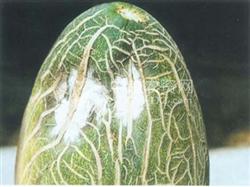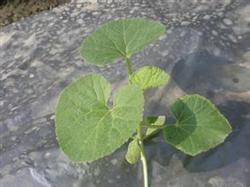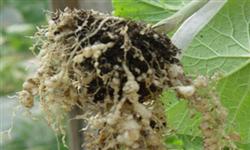Fusarium oxysporum fruit rot of Hami melon

Fusarium fruit rot of Hami melon, also known as white mildew, is an important disease on Hami melon, which mostly occurs during storage and transportation, and Hami melon and Bailan melon are vulnerable. The symptoms are mainly harmful to the fruit. At the beginning of the fruit stalk produced a round slightly sunken light brown spot, the size of 10-30mm, waterlogged around, some slightly cracked, the crack produced white velvet mycelium, sometimes pink, sometimes produced orange-red slime particles, that is, the conidia of the bacteria. The serious flesh of the disease is spongy, sweet and then purplish red, and the flesh is bitter and cannot be eaten. The characteristics of the disease are that Fusarium oxysporum widely exists in the soil and air, and saprophytic life. When the conditions are suitable, it can invade from the wound, and then produce conidia for re-infection. Control methods (1) breeding and planting disease-resistant varieties according to local conditions. (2) strengthen cultivation management. Timely harvest, not too late, do everything possible to reduce various wounds; control temperature and humidity during storage and transportation, cantaloupe 3-9 ℃, Bailan melon 5-8 ℃, relative humidity should not exceed 85%, and pay attention to ventilation and dampness. (3) Pesticide control. Spray more than 60% carbendazim hydrochloride (Fangmaibao) soluble powder 700 times or 50% carbendazim sulfonate (carbendazim) 800 times wettable powder at the initial stage of the disease. Commonly used agents Fangmaibao, carbendazim.
- Prev

Methods and techniques of soilless cultivation of Hami melon
In recent years, the area of anti-season cultivation of Hami melon in Hainan has gradually expanded by using economic greenhouse. Compared with open field cultivation, Hami melon is a kind of cash crop with high input and high output. The seed price of Hami melon is expensive and the disease in seedling stage is more serious. the causes of seedling death of Hami melon are described and the control methods are put forward. ...
- Next

Cantaloupe root knot nematode disease
Root-knot nematode disease is an important disease of Hami melon, which occurs and distributes in some areas. It can occur in protected and open fields. The disease is more serious in autumn. Infection in seedling stage has a great impact on production. After the disease, the rate of diseased plants is often more than 60%, which obviously affects the production of Hami melon. The symptoms are mainly harmful to the root system and occur on the main root and lateral root.
Related
- Moge, come on! The staff of the peasant association in the producing area of cantaloupe were frightened when the crowd gathered.
- Causes and Solutions of low Fruit setting rate of Apple
- Symptoms and control measures of passion fruit virus disease
- Fruit growing lesson: how do apple orchards keep high yields?
- Can you build orchards in the mountains? What are the pros and cons?
- How to manage the coloring period of Crisson grape?
- This paper introduces the processing technology of two kinds of fig products.
- How much is a month for retired teachers in rural areas by 2020?
- How can strawberry planting increase sugar content? We should pay attention to management in many aspects.
- What are the cultivation techniques on how to improve the yield of golden fruit?

